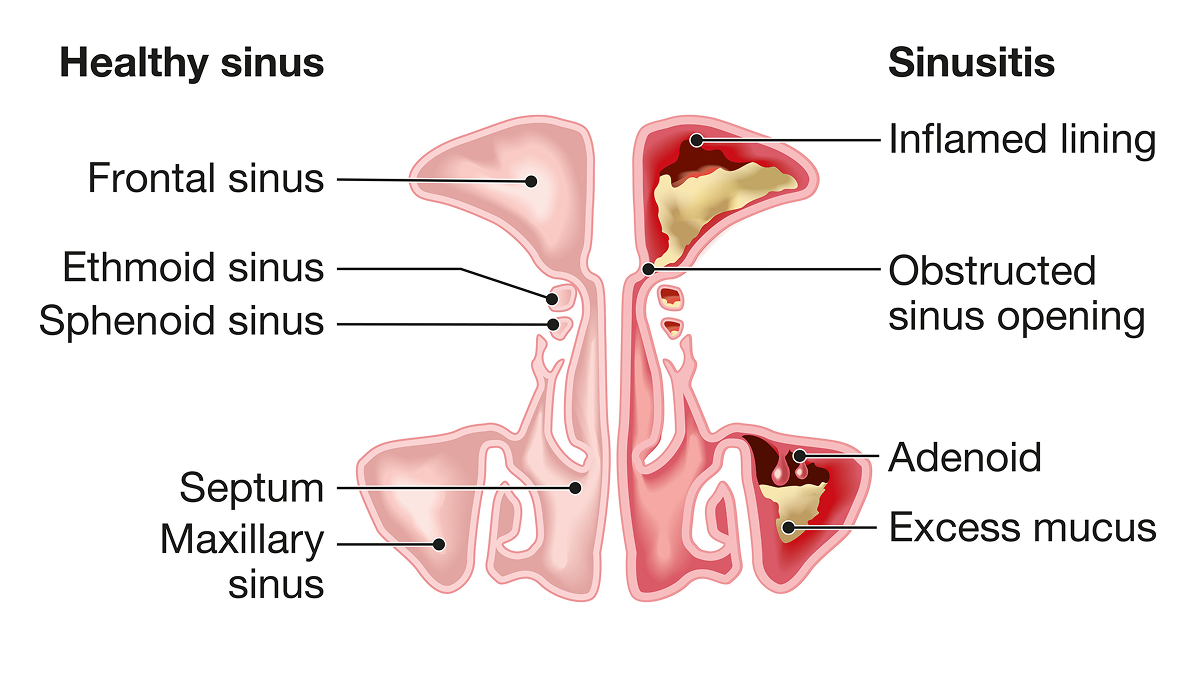Sinusitis
Find a doctorSinusitis is often a short-term illness that resolves on its own or with the help of a primary care provider. For sinusitis that does not respond to treatment or comes back, ear, nose and throat (ENT) doctors provide specialized care. Atrium Health Floyd and Harbin Clinic offers comprehensive ENT services to help you feel better.
What is sinusitis?
Your sinuses are hollow spaces in the bones behind your forehead, nose, cheeks and eyes. Healthy sinuses produce mucus that drains into your nose and down the back of your throat.
Sinusitis causes the tissues lining the sinuses to become inflamed and swollen, blocking the narrow passages. When this happens, mucus builds up, and bacteria and other germs can grow more easily.

This is a comparison of a healthy sinus with a sinus affected by sinusitis. Sinusitis causes inflammation, mucus buildup and blocked sinus openings.
Causes of sinusitis
Sinusitis is usually caused by a cold or allergies. Less common causes include:
- Medical conditions that affect the ability of the small hairs in the sinuses (cilia) to move mucus out
- Nasal problems that block the sinus openings, such as a deviated septum, nasal bone spur or nasal polyps
Sinusitis symptoms
Common symptoms of sinusitis include:
- Facial pain due to sinus pressure
- Nasal congestion from blocked sinus passages
- Nasal discharge that can be white, yellow, green or blood-tinged
- Post-nasal drainage of secretions down the back of your throat
You may also experience other symptoms, such as:
- Bad breath
- Cough
- Decreased sense of smell
- Fatigue
- Fever
- Sore throat
Rarely, sinusitis can cause a brain infection or other serious complications.
Sinusitis types
There are several types of sinusitis:
- Acute sinusitis: Lasts up to 4 weeks
- Subacute sinusitis: Lasts 4 to 12 weeks
- Chronic sinusitis: Lasts more than 12 weeks and can continue for months or years
- Recurrent sinusitis: Occurs several times in one year
Sinusitis diagnosis
Health care providers usually diagnose acute sinusitis by reviewing your symptoms and performing a physical exam. Your doctor may also examine the inside of your nose using a thin, flexible instrument (rhinoscope).
If your symptoms do not clearly indicate sinusitis or respond to treatment, your doctor may order tests such as:
- Allergy tests to identify potential allergic triggers
- Blood and other laboratory tests to rule out other conditions associated with sinusitis
- CT scan to assess the soft tissues and other structures inside your nose
- Cultures of the mucus inside your sinuses to check for an infection
Sinusitis risk factors
Factors that increase your risk of sinusitis include:
- Allergies
- Changes in altitude, such as when flying or scuba diving
- Colds and upper respiratory infections
- Enlarged adenoids (glands located at the back of your nose)
- Sinus disorders, such as nasal polyps and diseases that affect the cilia
- Smoking
- Weakened immune system
Sinusitis prevention
The following tips can help you stay healthy and prevent sinusitis:
- Avoid smoking and secondhand smoke
- Limit contact with people who are sick
- Stay up to date with recommended vaccinations, such as the flu and pneumococcal vaccines
- Use a clean humidifier
- Wash your hands frequently
Sinusitis treatment
There are many ways to treat sinusitis at home. To reduce congestion:
- Apply a warm, moist washcloth to your face several times a day
- Drink plenty of fluids
- Flush your sinuses using a Neti pot
- Inhale steam (such as while sitting in the bathroom with the shower running) two to four times per day
- Use a nasal saline spray
- Use a humidifier
Over-the-counter pain relievers and decongestants can also help relieve symptoms. Check with your doctor before using a nasal decongestant spray. It may help at first, but it can make nasal congestion worse if used for more than a few days.
Antibiotics are not usually needed for sinusitis, unless you have a bacterial infection. Even when antibiotics do help, they may only slightly reduce your healing time. Most people recover from sinusitis without antibiotics.
For sinusitis that doesn’t go away or comes back, your doctor may prescribe other medications or refer you to an ear, nose and throat (ENT) specialist. You may need surgery if you still don’t get better with other medications or treatments, or if you have fungal sinusitis.
Endoscopic sinus surgery (ESS) is a minimally invasive procedure used to treat fungal sinusitis, repair a deviated septum and remove nasal polyps. During ESS, the doctor can also open sinus passageways using a tiny balloon (sinuplasty).
Related conditions
Primary care
Personalized primary care from experts you trust
Get the MyAtriumHealth app
Get test results, message your provider & more.